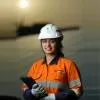

Hindustan Zinc Tops S&P Global Sustainability Rankings for Third Year
Hindustan Zinc, India’s only and the world’s largest integrated zinc producer and one of the top five global silver producers, has maintained its No. 1 global position in the Metals & Mining sector in the S&P Global Corporate Sustainability Assessment (CSA) 2025. As of 5 November 2025, the company earned an industry-leading score of 90, ranking first among 235 companies worldwide—its highest CSA score in five years and a continuation of its leadership for the third straight year.The S&P Global CSA is one of the world’s most respected ESG benchmarks, evaluating companies on ..

HCC Reports Rs 360.7 Million Net Profit for Q2 FY26
HCC E&C has reported a standalone turnover of Rs 9.57 billion and a net profit of Rs 360.7 million for Q2 FY26, compared to Rs 12.03 billion and 50.2 million, respectively, in Q2 FY25. As of September 30, 2025, the Company’s order book stood at Rs 131.52 billion. On a consolidated basis, HCC posted revenue of Rs 9.60 billion versus Rs 14.06 billion in the corresponding quarter last year; the figures are not comparable due to the divestment of Steiner AG in the previous fiscal. Consolidated profit for the quarter was Rs 470.8 million, compared to Rs 630.9 million in Q2 FY25.Financial High..

Carrier Japan’s USX Heat Pump Featured in WIPO’s Green Technology Book
Carrier Japan’s air-cooled modular chiller and heat pump series, Universal Smart X (USX), has been featured in the EXPO 2025 Special Edition of the Green Technology Book, published by the World Intellectual Property Organization (WIPO). Unveiled at EXPO 2025 Osaka, the publication highlights more than 200 impactful energy innovations from across the Asia-Pacific region, showcasing technologies that advance global sustainability. Carrier Japan is part of Carrier Global Corporation (NYSE: CARR), a global leader in intelligent climate and energy solutions.“Being featured in WIPO’s Green Tec..
















